ECU CHEVROLET UPLANDER 2006 Owners Manual
[x] Cancel search | Manufacturer: CHEVROLET, Model Year: 2006, Model line: UPLANDER, Model: CHEVROLET UPLANDER 2006Pages: 458, PDF Size: 3.19 MB
Page 7 of 458

Front Seats......................................................1-2
Manual Seats................................................1-2
Six-Way Power Seats.....................................1-3
Heated Seats.................................................1-3
Reclining Seatbacks........................................1-4
Head Restraints.............................................1-6
Rear Seats.......................................................1-6
Rear Seat Operation.......................................1-6
Bucket Seats.................................................1-7
Captain Chairs.............................................1-14
Third Row Seat............................................1-18
Safety Belts...................................................1-21
Safety Belts: They Are for Everyone................1-21
Questions and Answers About Safety Belts......1-25
How to Wear Safety Belts Properly.................1-26
Driver Position..............................................1-26
Shoulder Belt Height Adjustment.....................1-33
Safety Belt Use During Pregnancy..................1-34
Right Front Passenger Position.......................1-34
Rear Seat Passengers..................................1-34
Rear Safety Belt Comfort Guides....................1-37
Safety Belt Pretensioners...............................1-39
Safety Belt Extender.....................................1-39Child Restraints.............................................1-40
Older Children..............................................1-40
Infants and Young Children............................1-43
Child Restraint Systems.................................1-46
Where to Put the Restraint.............................1-50
Lower Anchors and Tethers for Children
(LATCH)..................................................1-52
Securing a Child Restraint in a
Rear Seat Position....................................1-58
Securing a Child Restraint in the Right
Front Seat Position....................................1-60
Built-In Child Restraint...................................1-64
Airbag System...............................................1-74
Where Are the Airbags?................................1-76
When Should an Airbag In�ate?.....................1-79
What Makes an Airbag In�ate?.......................1-80
How Does an Airbag Restrain?.......................1-80
What Will You See After an Airbag In�ates?.....1-81
Passenger Sensing System............................1-82
Servicing Your Airbag-Equipped Vehicle...........1-88
Adding Equipment to Your Airbag-Equipped
Vehicle....................................................1-88
Restraint System Check..................................1-89
Checking the Restraint Systems......................1-89
Replacing Restraint System Parts After a Crash . . .1-90
Section 1 Seats and Restraint Systems
1-1
ProCarManuals.com
Page 33 of 458
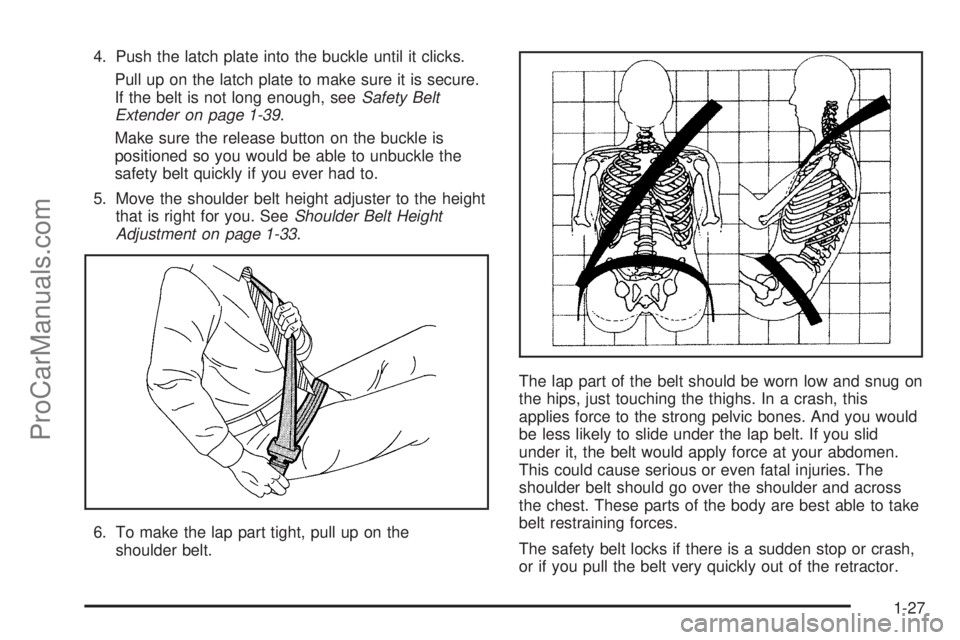
4. Push the latch plate into the buckle until it clicks.
Pull up on the latch plate to make sure it is secure.
If the belt is not long enough, seeSafety Belt
Extender on page 1-39.
Make sure the release button on the buckle is
positioned so you would be able to unbuckle the
safety belt quickly if you ever had to.
5. Move the shoulder belt height adjuster to the height
that is right for you. SeeShoulder Belt Height
Adjustment on page 1-33.
6. To make the lap part tight, pull up on the
shoulder belt.The lap part of the belt should be worn low and snug on
the hips, just touching the thighs. In a crash, this
applies force to the strong pelvic bones. And you would
be less likely to slide under the lap belt. If you slid
under it, the belt would apply force at your abdomen.
This could cause serious or even fatal injuries. The
shoulder belt should go over the shoulder and across
the chest. These parts of the body are best able to take
belt restraining forces.
The safety belt locks if there is a sudden stop or crash,
or if you pull the belt very quickly out of the retractor.
1-27
ProCarManuals.com
Page 41 of 458
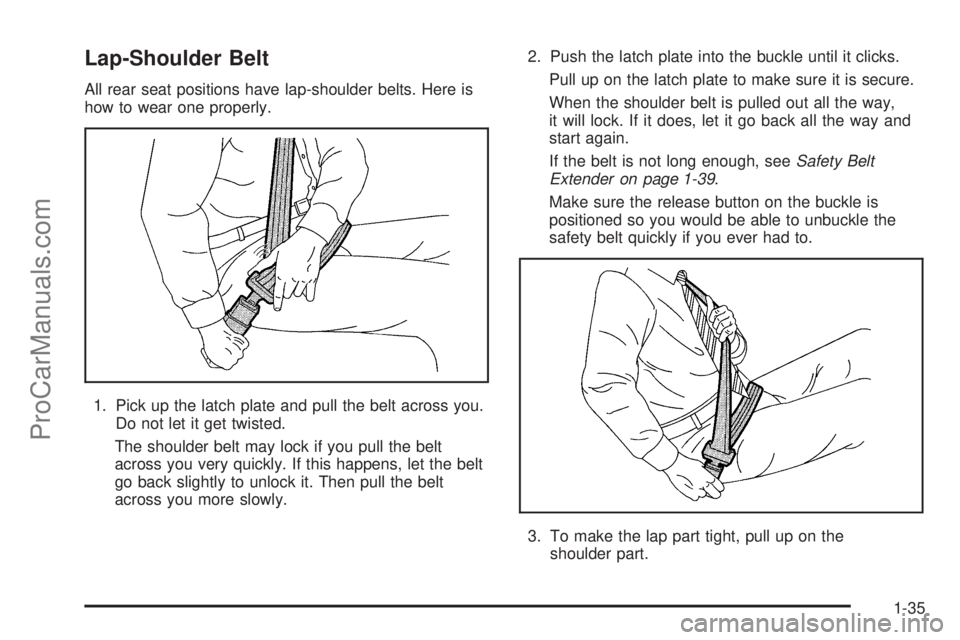
Lap-Shoulder Belt
All rear seat positions have lap-shoulder belts. Here is
how to wear one properly.
1. Pick up the latch plate and pull the belt across you.
Do not let it get twisted.
The shoulder belt may lock if you pull the belt
across you very quickly. If this happens, let the belt
go back slightly to unlock it. Then pull the belt
across you more slowly.2. Push the latch plate into the buckle until it clicks.
Pull up on the latch plate to make sure it is secure.
When the shoulder belt is pulled out all the way,
it will lock. If it does, let it go back all the way and
start again.
If the belt is not long enough, seeSafety Belt
Extender on page 1-39.
Make sure the release button on the buckle is
positioned so you would be able to unbuckle the
safety belt quickly if you ever had to.
3. To make the lap part tight, pull up on the
shoulder part.
1-35
ProCarManuals.com
Page 45 of 458
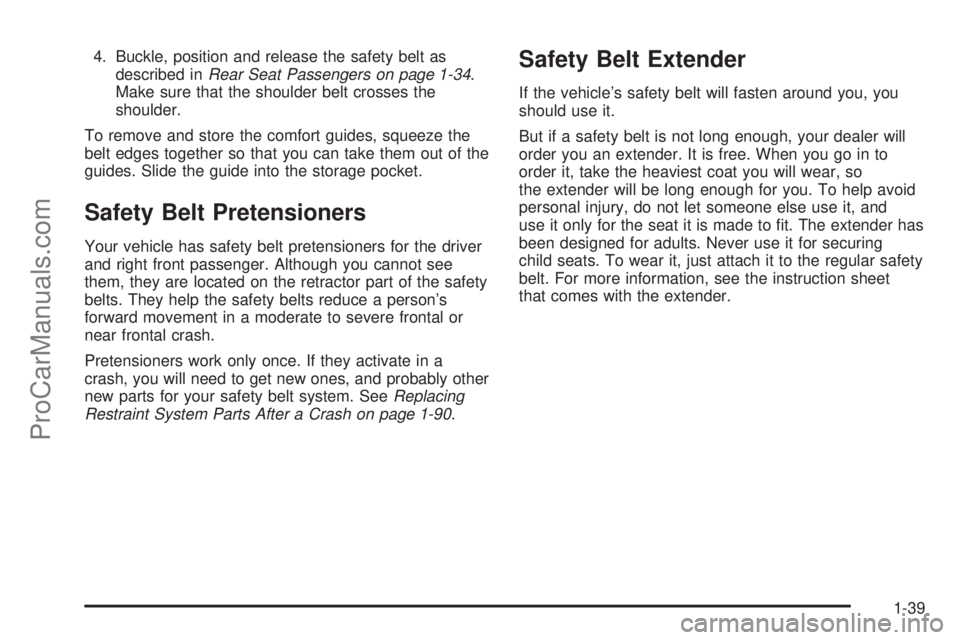
4. Buckle, position and release the safety belt as
described inRear Seat Passengers on page 1-34.
Make sure that the shoulder belt crosses the
shoulder.
To remove and store the comfort guides, squeeze the
belt edges together so that you can take them out of the
guides. Slide the guide into the storage pocket.
Safety Belt Pretensioners
Your vehicle has safety belt pretensioners for the driver
and right front passenger. Although you cannot see
them, they are located on the retractor part of the safety
belts. They help the safety belts reduce a person’s
forward movement in a moderate to severe frontal or
near frontal crash.
Pretensioners work only once. If they activate in a
crash, you will need to get new ones, and probably other
new parts for your safety belt system. SeeReplacing
Restraint System Parts After a Crash on page 1-90.
Safety Belt Extender
If the vehicle’s safety belt will fasten around you, you
should use it.
But if a safety belt is not long enough, your dealer will
order you an extender. It is free. When you go in to
order it, take the heaviest coat you will wear, so
the extender will be long enough for you. To help avoid
personal injury, do not let someone else use it, and
use it only for the seat it is made to �t. The extender has
been designed for adults. Never use it for securing
child seats. To wear it, just attach it to the regular safety
belt. For more information, see the instruction sheet
that comes with the extender.
1-39
ProCarManuals.com
Page 49 of 458
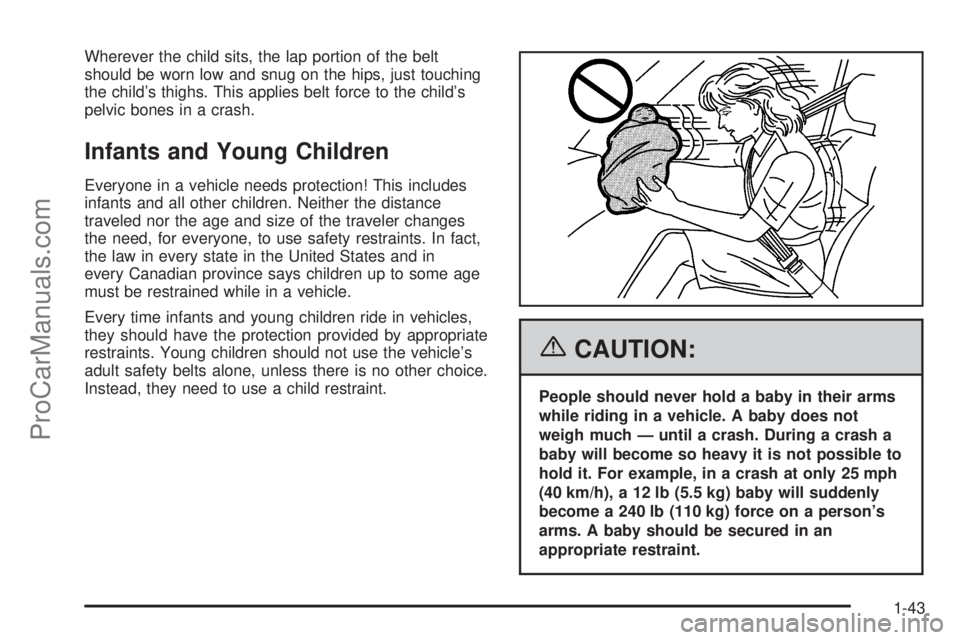
Wherever the child sits, the lap portion of the belt
should be worn low and snug on the hips, just touching
the child’s thighs. This applies belt force to the child’s
pelvic bones in a crash.
Infants and Young Children
Everyone in a vehicle needs protection! This includes
infants and all other children. Neither the distance
traveled nor the age and size of the traveler changes
the need, for everyone, to use safety restraints. In fact,
the law in every state in the United States and in
every Canadian province says children up to some age
must be restrained while in a vehicle.
Every time infants and young children ride in vehicles,
they should have the protection provided by appropriate
restraints. Young children should not use the vehicle’s
adult safety belts alone, unless there is no other choice.
Instead, they need to use a child restraint.
{CAUTION:
People should never hold a baby in their arms
while riding in a vehicle. A baby does not
weigh much — until a crash. During a crash a
baby will become so heavy it is not possible to
hold it. For example, in a crash at only 25 mph
(40 km/h), a 12 lb (5.5 kg) baby will suddenly
become a 240 lb (110 kg) force on a person’s
arms. A baby should be secured in an
appropriate restraint.
1-43
ProCarManuals.com
Page 51 of 458
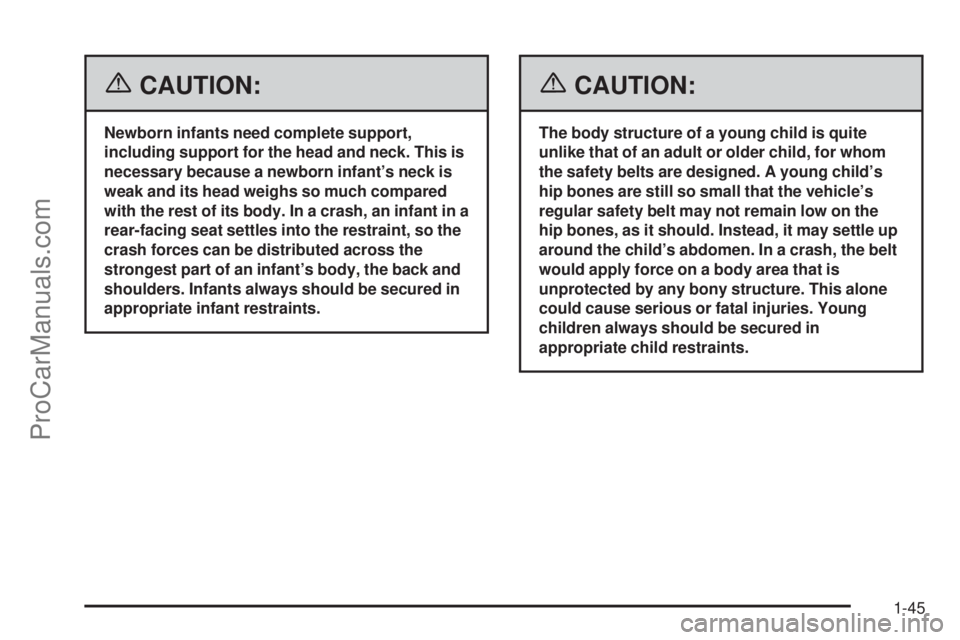
{CAUTION:
Newborn infants need complete support,
including support for the head and neck. This is
necessary because a newborn infant’s neck is
weak and its head weighs so much compared
with the rest of its body. In a crash, an infant in a
rear-facing seat settles into the restraint, so the
crash forces can be distributed across the
strongest part of an infant’s body, the back and
shoulders. Infants always should be secured in
appropriate infant restraints.
{CAUTION:
The body structure of a young child is quite
unlike that of an adult or older child, for whom
the safety belts are designed. A young child’s
hip bones are still so small that the vehicle’s
regular safety belt may not remain low on the
hip bones, as it should. Instead, it may settle up
around the child’s abdomen. In a crash, the belt
would apply force on a body area that is
unprotected by any bony structure. This alone
could cause serious or fatal injuries. Young
children always should be secured in
appropriate child restraints.
1-45
ProCarManuals.com
Page 54 of 458
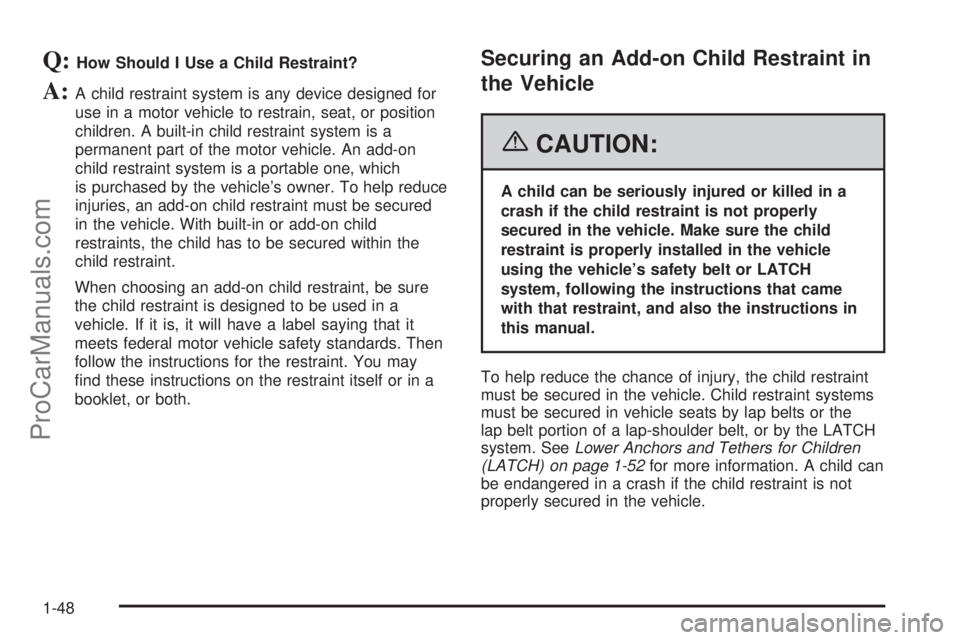
Q:How Should I Use a Child Restraint?
A:A child restraint system is any device designed for
use in a motor vehicle to restrain, seat, or position
children. A built-in child restraint system is a
permanent part of the motor vehicle. An add-on
child restraint system is a portable one, which
is purchased by the vehicle’s owner. To help reduce
injuries, an add-on child restraint must be secured
in the vehicle. With built-in or add-on child
restraints, the child has to be secured within the
child restraint.
When choosing an add-on child restraint, be sure
the child restraint is designed to be used in a
vehicle. If it is, it will have a label saying that it
meets federal motor vehicle safety standards. Then
follow the instructions for the restraint. You may
�nd these instructions on the restraint itself or in a
booklet, or both.
Securing an Add-on Child Restraint in
the Vehicle
{CAUTION:
A child can be seriously injured or killed in a
crash if the child restraint is not properly
secured in the vehicle. Make sure the child
restraint is properly installed in the vehicle
using the vehicle’s safety belt or LATCH
system, following the instructions that came
with that restraint, and also the instructions in
this manual.
To help reduce the chance of injury, the child restraint
must be secured in the vehicle. Child restraint systems
must be secured in vehicle seats by lap belts or the
lap belt portion of a lap-shoulder belt, or by the LATCH
system. SeeLower Anchors and Tethers for Children
(LATCH) on page 1-52for more information. A child can
be endangered in a crash if the child restraint is not
properly secured in the vehicle.
1-48
ProCarManuals.com
Page 55 of 458
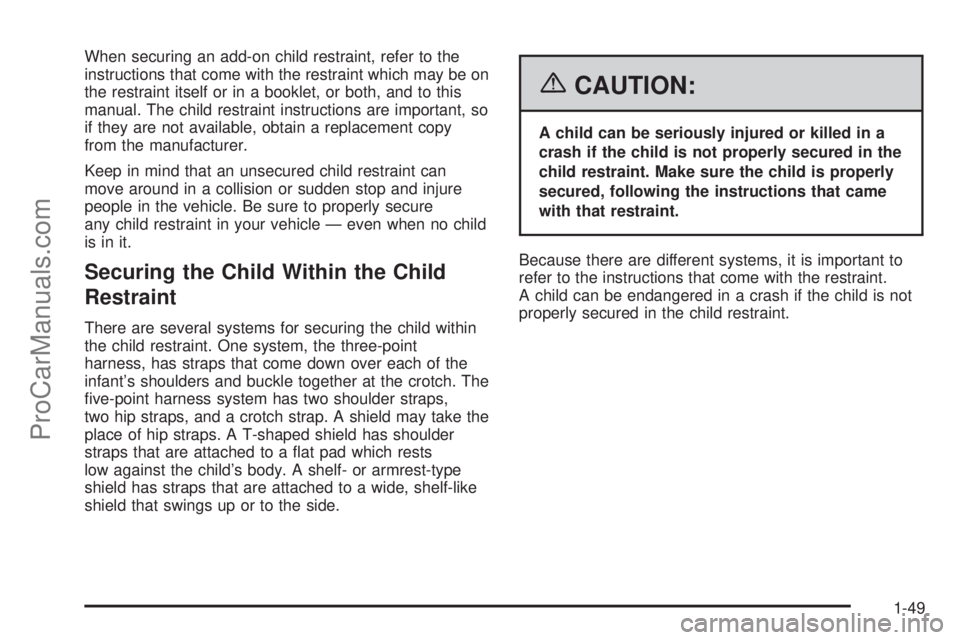
When securing an add-on child restraint, refer to the
instructions that come with the restraint which may be on
the restraint itself or in a booklet, or both, and to this
manual. The child restraint instructions are important, so
if they are not available, obtain a replacement copy
from the manufacturer.
Keep in mind that an unsecured child restraint can
move around in a collision or sudden stop and injure
people in the vehicle. Be sure to properly secure
any child restraint in your vehicle — even when no child
is in it.
Securing the Child Within the Child
Restraint
There are several systems for securing the child within
the child restraint. One system, the three-point
harness, has straps that come down over each of the
infant’s shoulders and buckle together at the crotch. The
�ve-point harness system has two shoulder straps,
two hip straps, and a crotch strap. A shield may take the
place of hip straps. A T-shaped shield has shoulder
straps that are attached to a �at pad which rests
low against the child’s body. A shelf- or armrest-type
shield has straps that are attached to a wide, shelf-like
shield that swings up or to the side.
{CAUTION:
A child can be seriously injured or killed in a
crash if the child is not properly secured in the
child restraint. Make sure the child is properly
secured, following the instructions that came
with that restraint.
Because there are different systems, it is important to
refer to the instructions that come with the restraint.
A child can be endangered in a crash if the child is not
properly secured in the child restraint.
1-49
ProCarManuals.com
Page 56 of 458
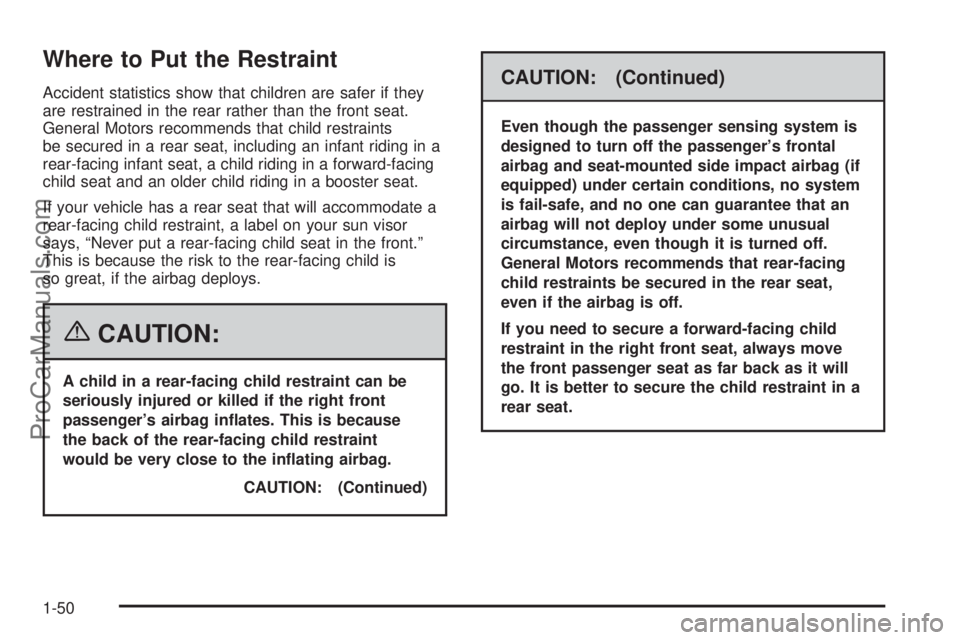
Where to Put the Restraint
Accident statistics show that children are safer if they
are restrained in the rear rather than the front seat.
General Motors recommends that child restraints
be secured in a rear seat, including an infant riding in a
rear-facing infant seat, a child riding in a forward-facing
child seat and an older child riding in a booster seat.
If your vehicle has a rear seat that will accommodate a
rear-facing child restraint, a label on your sun visor
says, “Never put a rear-facing child seat in the front.”
This is because the risk to the rear-facing child is
so great, if the airbag deploys.
{CAUTION:
A child in a rear-facing child restraint can be
seriously injured or killed if the right front
passenger’s airbag in�ates. This is because
the back of the rear-facing child restraint
would be very close to the in�ating airbag.
CAUTION: (Continued)
CAUTION: (Continued)
Even though the passenger sensing system is
designed to turn off the passenger’s frontal
airbag and seat-mounted side impact airbag (if
equipped) under certain conditions, no system
is fail-safe, and no one can guarantee that an
airbag will not deploy under some unusual
circumstance, even though it is turned off.
General Motors recommends that rear-facing
child restraints be secured in the rear seat,
even if the airbag is off.
If you need to secure a forward-facing child
restraint in the right front seat, always move
the front passenger seat as far back as it will
go. It is better to secure the child restraint in a
rear seat.
1-50
ProCarManuals.com
Page 57 of 458
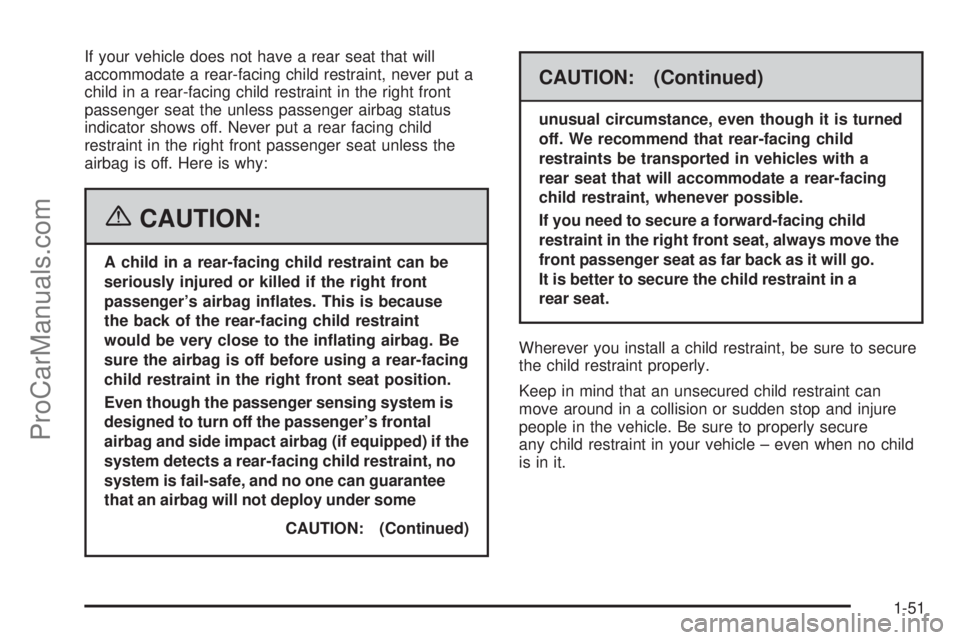
If your vehicle does not have a rear seat that will
accommodate a rear-facing child restraint, never put a
child in a rear-facing child restraint in the right front
passenger seat the unless passenger airbag status
indicator shows off. Never put a rear facing child
restraint in the right front passenger seat unless the
airbag is off. Here is why:
{CAUTION:
A child in a rear-facing child restraint can be
seriously injured or killed if the right front
passenger’s airbag in�ates. This is because
the back of the rear-facing child restraint
would be very close to the in�ating airbag. Be
sure the airbag is off before using a rear-facing
child restraint in the right front seat position.
Even though the passenger sensing system is
designed to turn off the passenger’s frontal
airbag and side impact airbag (if equipped) if the
system detects a rear-facing child restraint, no
system is fail-safe, and no one can guarantee
that an airbag will not deploy under some
CAUTION: (Continued)
CAUTION: (Continued)
unusual circumstance, even though it is turned
off. We recommend that rear-facing child
restraints be transported in vehicles with a
rear seat that will accommodate a rear-facing
child restraint, whenever possible.
If you need to secure a forward-facing child
restraint in the right front seat, always move the
front passenger seat as far back as it will go.
It is better to secure the child restraint in a
rear seat.
Wherever you install a child restraint, be sure to secure
the child restraint properly.
Keep in mind that an unsecured child restraint can
move around in a collision or sudden stop and injure
people in the vehicle. Be sure to properly secure
any child restraint in your vehicle – even when no child
is in it.
1-51
ProCarManuals.com